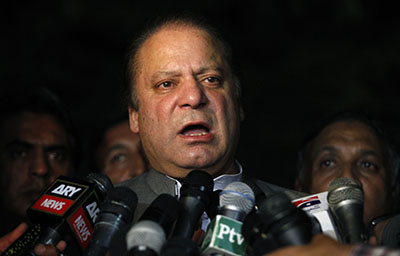Pakistan’s general elections in May, though marred by violence that left more than 100 dead, was a reaffirmation of the people’s commitment to the democratic process. Voters proved once again that they can make decisions based on their own political interests–and not because of intimidation by those who would perpetrate violence. The media, with their nonstop coverage, arrived as full-fledged partners in the democratic process and were intrinsic to the first civilian transfer of power after the completion of a five-year term by a democratically elected government. Now, the question is: What will come next for the media under Prime Minister Nawaz Sharif’s government?
Clearly, the country has moved far beyond the days of Sharif’s former administrations. It would be a massive failure on his part to revert to the strongman tactics he used when he was last in office. A look back at CPJ’s archives shows that Sharif was anything but media-friendly–or even media-tolerant. In 2001, we referred to “the bare-knuckle tactics that former Prime Minister Nawaz Sharif used to control the press” before he was deposed by Gen. Pervez Musharraf. In 1999, we wrote an open letter to Sharif: “The Committee to Protect Journalists is shocked by the range of tactics your administration is using to harass and intimidate the Jang Group of Newspapers, Pakistan’s largest newspaper publishing company.”
The more you delve, the worse Sharif’s record looks. In her March 2002 special report Pakistan: The Press for Change, CPJ’s Kavita Menon nailed Sharif’s behavior succinctly:
In his two and a half years in power, Sharif had made a reputation for himself as a bully–not least because of the heavy-handed way he dealt with journalists who dared to criticize his government. Sharif was not unique in exploiting official power to silence his detractors. Pakistan has suffered a host of thin-skinned rulers, virtually all of whom, whether democratically elected or self-appointed, have used the available state machinery to try to control the press. But the Sharif administration did so with particular zeal and efficiency. His government ratcheted up the pressure on independent journalists, coupling more oblique strategies of muzzling the press with increasingly aggressive, public shows of retribution.
Want more evidence? Here’s a telling excerpt from CPJ’s 1999 Attacks on the Press:
Former Prime Minister Muhammad Nawaz Sharif’s efforts to muzzle the press, and bring the legislative, judicial, and executive branches of government under his personal control, earned him the reputation of a tyrant and badly discredited Pakistan’s democracy. His slide toward authoritarianism ended abruptly with a bloodless coup on October 12, in which army chief Gen. Pervez Musharraf took power.
When Musharraf took power, he immediately declared himself “a firm believer in the freedom of the press,” then referred to the press’s duty to “play a positive and constructive role.” He also made it clear he would be the one deciding whether or not the media were doing their job. Despite his battles with the media, broadcast news grew exponentially during his administration with the spread of cable TV technology. As with Sharif, CPJ proceeded to go head to head with the military leader.
It was journalists and lawyers who took to the streets (often at odds with each other, it must be said) who brought down Musharraf. And they did not step away from confronting former President Asif Ali Zardari. For his part, Zardari felt he could play hard with the media as if it were still the good old bad old days. When his government proved incapable of coping with disastrous flooding in 2010, his party loyalists kicked major news broadcasters ARY TV and Geo TV off the air in Sindh province. Even though impunity in journalist murders accelerated during his tenure, the press increasingly repelled his attempts to control or cow them.
Clearly, the country and the local press are different after Musharraf and Zardari. The concern is not so much that that Prime Minister Sharif will be so foolish as to try the same strongman tactics that were his modus operandi in 1999. The fear is that the arrogance will still be there, and he will make the Zardari-type blunders of the post-Musharraf military rule era. Given the political ineptitude of the past decades, there is a crying need for the launch of real governance and not just more of the same power-base politics. The prime minister has to accept that the media are integral to the functioning of the democratic process that brought him to power in Pakistan.
As Menon correctly wrote in her 2002 report, “The press in Pakistan, despite more than four decades of government efforts to control it, is remarkably vigorous and aggressive.” Now, in 2013, we can update that to “five decades and counting” of remarkable vigor and aggression. Let’s hope Sharif’s government can keep pace with the growth of the media.
